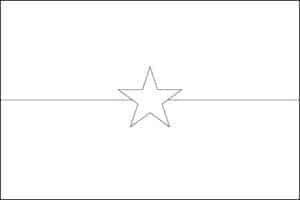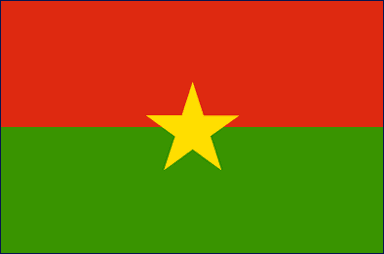
The national flag of Burkina Faso is composed of a horizontal red top half and a horizontal green bottom half. The center of the Burkina Faso flag is a five-pointed yellow star.
Green symbolizes the wealth of natural resources in the country, while crimson stands for the revolution. Last but not least, the brilliant yellow star stands for the rebels’ guiding light.
Facts about the Burkina Faso flag |
| Country | Burkina Faso |
|---|---|
| Designed by | NA |
| Adopted | August 4, 1984 |
| Revision | NA |
| Design and Colors | A horizontal bicolor of red and green with a yellow star in the center |
| Size Ratio | 2:3 |
| Official Name: | Burkina Faso |
| Proportion: | 2:3 |
| Adopted on: | August 4, 1984 |
| Location: | West Africa is bordered by Mali, Niger, Benin, Togo, Ghana, and Cote d’Ivoire |
| Capital City: | Ouagadougou |
| Major Cities: | Boromo, Koudougou, Pama, Hounde |
| Area: | 105,900 square miles |
| Population: | 15,730,977 |
| Currency: | West African CFA franc (XOF) |
| Official Language: | French |
| National Anthem: | One Single Night |
| National symbol(s): | white stallion |
| National colors: | red, yellow, green |
| National anthem: | |
| Name: | “Le Ditanye” (Anthem of Victory) |
| Lyrics/Music: | Thomas SANKARA |
Historical Background
The current design of the Burkina Faso flag was officially adopted on August 4, 1984, following a revolution that led to the change of the country’s name from Upper Volta to Burkina Faso (“Land of Incorruptible People”). The flag’s design reflects the ideals of the revolution and the nation’s vision for a better future.
Design and Colors
The Burkina Faso flag features two horizontal bands of equal width – red on the top and green at the bottom. In the center of the red band, there is a yellow five-pointed star.
Symbolism of the Burkina Faso Flag
Each element of the Burkina Faso flag holds significant symbolism. The red color represents the revolutionary struggle for independence and the sacrifice of the Burkinabé people. The green color symbolizes the country’s rich agricultural resources and its hope for a prosperous future. The yellow five-pointed star in the center represents the guiding light of the revolution and the nation’s determination to move toward progress and unity.
Burkina Faso Independence Day
Burkina Faso Independence Day is celebrated on August 5th each year, commemorating the day in 1960 when Burkina Faso (then Upper Volta) gained independence from French colonial rule. This day is marked by various celebrations, parades, and flag-raising ceremonies, showcasing the importance of the Burkina Faso flag as a symbol of independence and national identity.
FAQs
Q1: When was the current design of the Burkina Faso flag adopted?
The current design of the Burkina Faso flag was officially adopted on August 4, 1984.
Q2: What do the colors on the Burkina Faso flag represent?
The red color represents the revolutionary struggle for independence and the sacrifice of the Burkinabé people, the green color symbolizes the country’s rich agricultural resources and hopes for a prosperous future, and the yellow five-pointed star represents the guiding light of the revolution and the nation’s determination to move towards progress and unity.
Q3: What is Burkina Faso Independence Day?
Burkina Faso Independence Day is celebrated on August 5th each year, commemorating the day in 1960 when Burkina Faso (then Upper Volta) gained independence from French colonial rule.
Q4: What is the significance of the revolution in the history of Burkina Faso?
The revolution in Burkina Faso, which led to the adoption of the current flag, was a pivotal moment in the country’s history. It brought about a change in the country’s name from Upper Volta to Burkina Faso, symbolizing the nation’s vision for a better future and the pursuit of progress and unity.

